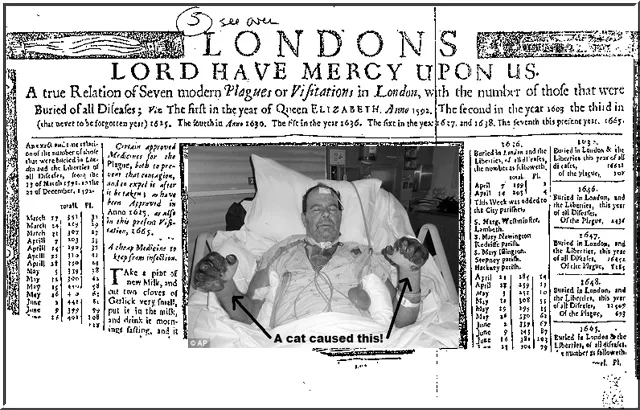The book Cat Owner's Home Veterinary Handbook, states: "This disease is of concern because of potential cat-to-human transmission". Although, people should not be too concerned in my opinion because the disease is spread by flea bites (and fleas rarely bite people and the disease is very rare) but it can be transmitted by airborne exposure. I believe that the airborne exposure transmission as a result of it showing up as a septicaemic disease in the bloodstream or pneumonic plague in the lungs, in which case, cats may spread the disease by coughing out infected droplets.
I'm told that the most common mode of transmission to humans is the bite of an infected flea and cats and dogs can bring the flea to their human companion from plague-infective wildlife such as a rodent. A sick cat can also transmit the bacteria to others through bites or scratches.
Bubonic plague is caused by bacteria called Yersinia pestis. There are 13 cases of bubonic plague in people in the United States annually. The disease may be on the increase. Nearly all cases occur in California, Arizona and New Mexico.
Cats can acquire the disease by mouth contact with infected rodents or by the bite of infected fleas. Cats are susceptible to the disease, although thankfully the infection is mild or asymptomatic in around 50% of cases.
Shortly after exposure to the disease cats show signs of illness including: difficulty breathing, coughing, mouth ulcers, dehydration, depression and apathy, loss of appetite and high fever.
Swellings occur in the lymph nodes especially beneath the jaw. They form abscesses containing infective material. A veterinarian will diagnose the disease by a chest x-ray, blood tests to check for antibodies, blood and tissue cultures and gram stains.
My book also tells me that "great care must be taken by all people involved in the care of a plague-infected cat." Strict hygiene and isolation precautions should be in place after professional advice. The cat should be hospitalised. The disease can kill quickly. Treatment should be started before the diagnosis is confirmed. Antibiotics are prescribed but they maybe need to be given four weeks.
Preventative measures include the control of fleas as the most important proactive step. Reducing the roaming and hunting of cats reduces their exposure to plague.
The plague is not found in the UK. It is in the USA and Africa, Asia, South America. When the black death as it was called in the 17th-century hit England in the late 1300s the experts initially believed that cats were spreading the disease. They killed all the cats which made the situation worse because it was the fleas on the rats which was perpetuating the disease.

No comments:
Post a Comment
Your comments are always welcome.